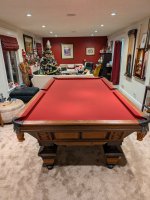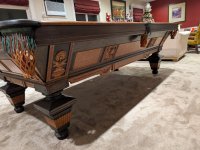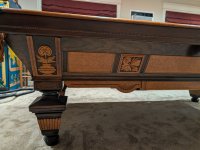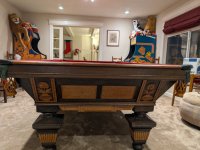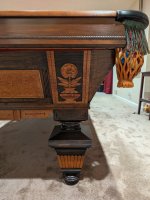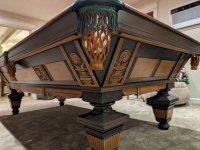I am not a mechanic.
It sounds like you are still in the research stage. That's good. You need a bunch more research. Antique tables are constructed differently and many will need the entire rails beveled at a different angle to fit modern cushions, even if you don't do anything with the pockets this will need to be done if replacing the rubber with modern rubber.
For some homework, look up "diamondize" "diamondizing" "diamondized" and "sub rail extension" on google. In google in the search box type:
site:
www.website.com then your search term. The search here is kind of bad, but if you search the forum through google you will find a lot of info.
Basically the pockets have a compound angle and it's not as simple as just chopping off a piece of wood and sticking it to the current wood. You have to do the correct angle both horizontally and vertically.
This
is a thread where I fixed my Olhausen. It's not the "correct" way by doing a subrail extension, but it worked great. That 50 durometer rubber is the key if you go this way. It's softer than the 60 durometer type so it plays better on thicker facings.
Pay special attention to threads on diamondizing where
@realkingcobra posts. He is one of the top guys to do this kind of work. There are other mechanics that can do this but I think Glen is one of the best and also one who shares more info on the nuts and bolts of the process.
Personally I think I'd be really careful with whatever you do to the table, it's an antique, and they aren't making more of them should a mistake occur. Arm yourself with this info, even if you decide not to go the DIY route because 95% of the self proclaimed mechanics cant or wont do this type of work. It's kind of like how your local garage can easily do a brake job but might not be the person you go to to port your race engine. Most "mechanics" are very good at moving a table, at putting on cloth, some can level a table properly, but when it comes to actually changing and tuning a table, most fall flat on their face.
If you're handy you could do the work, but you're going to have to put some work in to intimately understand what you must do to minimize the risk of ruining an antique table.
Personally if your rubber is good and you had to have a tight table I'd do something similar to in my olhausen fix thread linked earlier. That's way less likely to cause permanent damage to the table and it could be put back to original specs if you wanted. I'm sure your table is a cool one. I'd be tempted to leave it as is and learn straight pool.
